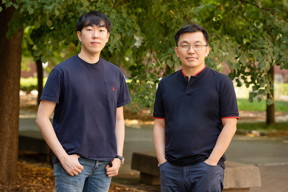Home > Press > Octopus-inspired sucker transfers thin, delicate tissue grafts and biosensors
 |
| Postdoctoral researcher Byoungsoo Kim and professor Hyunjoon Kong led a team that developed an octopus-inspired device for transferring fragile, thin sheets of tissue or flexible electronics.
Photo by L. Brian Stauffer |
Abstract:
Thin tissue grafts and flexible electronics have a host of applications for wound healing, regenerative medicine and biosensing. A new device inspired by an octopuss sucker rapidly transfers delicate tissue or electronic sheets to the patient, overcoming a key barrier to clinical application, according to researchers at the University of Illinois at Urbana-Champaign and collaborators.
Octopus-inspired sucker transfers thin, delicate tissue grafts and biosensors
Champaign, IL | Posted on October 16th, 2020
For the last few decades, cell or tissue sheets have been increasingly used to treat injured or diseased tissues. A crucial aspect of tissue transplantation surgery, such as corneal tissue transplantation surgery, is surgical gripping and safe transplantation of soft tissues. However, handling these living substances remains a grand challenge because they are fragile and easily crumple when picking them up from the culture media, said study leader Hyunjoon Kong, a professor of chemical and biomolecular engineering at Illinois.
Kongs group, along with collaborators at Purdue University, the University of Illinois at Chicago, Chung-Ang University in South Korea, and the Korea Advanced Institute for Science and Technology, published their work in the journal Science Advances.
Current methods of transferring the sheets involve growing them on a temperature-sensitive soft polymer that, once transferred, shrinks and releases the thin film. However, this process takes 30-60 minutes to transfer a single sheet, requires skilled technicians and runs the risk of tearing or wrinkling, Kong said.
During surgery, surgeons must minimize the risk of damage to soft tissues and transplant quickly, without contamination. Also, transfer of ultrathin materials without wrinkle or damage is another crucial aspect, Kong said.
Seeking a way to quickly pick up and release the thin, delicate sheets of cells or electronics without damaging them, the researchers turned to the animal kingdom for inspiration. Seeing the way an octopus or squid can pick up both wet and dry objects of all shapes with small pressure changes in their muscle-powered suction cups, rather than a sticky chemical adhesive, gave the researchers an idea.
They designed a manipulator made of a temperature-responsive layer of soft hydrogel attached to an electric heater. To pick up a thin sheet, the researchers gently heat the hydrogel to shrink it, then press it to the sheet and turn off the heat. The hydrogel expands slightly, creating suction with the soft tissue or flexible electronic film so it can be lifted and transferred. Then they gently place the thin film on the target and turn the heater back on, shrinking the hydrogel and releasing the sheet.
The entire process takes about 10 seconds. See a video on YouTube.
Next, the researchers hope to integrate sensors into the manipulator, to further take advantage of their soft, bio-inspired design.
For example, by integrating pressure sensors with the manipulator, it would be possible to monitor the deformation of target objects during contact and, in turn, adjust the suction force to a level at which materials retain their structural integrity and functionality, Kong said. By doing so, we can improve the safety and accuracy of handling these materials. In addition, we aim to examine therapeutic efficacy of cells and tissues transferred by the soft manipulator.
The National Science Foundation, the National Institutes of Health, the Department of Defense Vision Research Program and the Jump Applied Research in Community Health through Engineering and Simulation endowment supported this work.
####
For more information, please click here
Contacts:
LIZ AHLBERG TOUCHSTONE
BIOMEDICAL SCIENCES EDITOR
217-244-1073
Hyunjoon Kong
(217) 333-1178
Copyright © University of Illinois at Urbana-Champaign
If you have a comment, please Contact us.
Issuers of news releases, not 7th Wave, Inc. or Nanotechnology Now, are solely responsible for the accuracy of the content.
News and information
![]() Deca Partners with ADTEC Engineering to Enhance Adaptive Patterning for 2µm Chiplet Scaling October 20th, 2020
Deca Partners with ADTEC Engineering to Enhance Adaptive Patterning for 2µm Chiplet Scaling October 20th, 2020
![]() Graphenea awarded Best Graphene Firm prize October 20th, 2020
Graphenea awarded Best Graphene Firm prize October 20th, 2020
![]() Veeco Announces Aledia Order of 300mm MOCVD Equipment for microLED Displays: Propel Platform First 300mm System with EFEM Designed for Advanced Display Applications October 20th, 2020
Veeco Announces Aledia Order of 300mm MOCVD Equipment for microLED Displays: Propel Platform First 300mm System with EFEM Designed for Advanced Display Applications October 20th, 2020
![]() Revealing the reason behind jet formation at the tip of laser optical fiber October 16th, 2020
Revealing the reason behind jet formation at the tip of laser optical fiber October 16th, 2020
Flexible Electronics
![]() HKU Engineering team develops novel miniaturised organic semiconductor: An important breakthrough essential for future flexible electronic devices October 8th, 2020
HKU Engineering team develops novel miniaturised organic semiconductor: An important breakthrough essential for future flexible electronic devices October 8th, 2020
![]() Solid-state intramolecular motions in continuous fibers for fluorescent humidity sensor July 16th, 2020
Solid-state intramolecular motions in continuous fibers for fluorescent humidity sensor July 16th, 2020
Videos/Movies
![]() Materials scientists learn how to make liquid crystal shape-shift September 25th, 2020
Materials scientists learn how to make liquid crystal shape-shift September 25th, 2020
![]() Engineers produce a fisheye lens that’s completely flat: The single piece of glass produces crisp panoramic images September 22nd, 2020
Engineers produce a fisheye lens that’s completely flat: The single piece of glass produces crisp panoramic images September 22nd, 2020
![]() Physicists find misaligned carbon sheets yield unparalleled properties July 31st, 2020
Physicists find misaligned carbon sheets yield unparalleled properties July 31st, 2020
Possible Futures
![]() Deca Partners with ADTEC Engineering to Enhance Adaptive Patterning for 2µm Chiplet Scaling October 20th, 2020
Deca Partners with ADTEC Engineering to Enhance Adaptive Patterning for 2µm Chiplet Scaling October 20th, 2020
![]() Graphenea awarded Best Graphene Firm prize October 20th, 2020
Graphenea awarded Best Graphene Firm prize October 20th, 2020
![]() Veeco Announces Aledia Order of 300mm MOCVD Equipment for microLED Displays: Propel Platform First 300mm System with EFEM Designed for Advanced Display Applications October 20th, 2020
Veeco Announces Aledia Order of 300mm MOCVD Equipment for microLED Displays: Propel Platform First 300mm System with EFEM Designed for Advanced Display Applications October 20th, 2020
![]() Multi-state data storage leaving binary behind: Stepping ‘beyond binary’ to store data in more than just 0s and 1s October 16th, 2020
Multi-state data storage leaving binary behind: Stepping ‘beyond binary’ to store data in more than just 0s and 1s October 16th, 2020
Nanomedicine
![]() New drug carrier systems: University of Delaware researchers advance drug delivery systems to treat connective tissue disorders October 9th, 2020
New drug carrier systems: University of Delaware researchers advance drug delivery systems to treat connective tissue disorders October 9th, 2020
![]() HKU Engineering team develops novel miniaturised organic semiconductor: An important breakthrough essential for future flexible electronic devices October 8th, 2020
HKU Engineering team develops novel miniaturised organic semiconductor: An important breakthrough essential for future flexible electronic devices October 8th, 2020
![]() ‘Like a fishing net,’ nanonet collapses to trap drug molecule: New method presents possibilities for rapidly making and testing vaccine formulations October 6th, 2020
‘Like a fishing net,’ nanonet collapses to trap drug molecule: New method presents possibilities for rapidly making and testing vaccine formulations October 6th, 2020
Sensors
![]() The most sensitive and fastest graphene microwave bolometer September 30th, 2020
The most sensitive and fastest graphene microwave bolometer September 30th, 2020
![]() An improved wearable, stretchable gas sensor using nanocomposites August 28th, 2020
An improved wearable, stretchable gas sensor using nanocomposites August 28th, 2020
![]() Nano-diamond self-charging batteries could disrupt energy as we know it August 25th, 2020
Nano-diamond self-charging batteries could disrupt energy as we know it August 25th, 2020
![]() Synthesis of organophilic carbon nanodots with multi-band emission from tomato leaves August 21st, 2020
Synthesis of organophilic carbon nanodots with multi-band emission from tomato leaves August 21st, 2020
Discoveries
![]() Revealing the reason behind jet formation at the tip of laser optical fiber October 16th, 2020
Revealing the reason behind jet formation at the tip of laser optical fiber October 16th, 2020
![]() Multi-state data storage leaving binary behind: Stepping ‘beyond binary’ to store data in more than just 0s and 1s October 16th, 2020
Multi-state data storage leaving binary behind: Stepping ‘beyond binary’ to store data in more than just 0s and 1s October 16th, 2020
![]() Surface waves can help nanostructured devices keep their cool October 12th, 2020
Surface waves can help nanostructured devices keep their cool October 12th, 2020
Announcements
![]() Deca Partners with ADTEC Engineering to Enhance Adaptive Patterning for 2µm Chiplet Scaling October 20th, 2020
Deca Partners with ADTEC Engineering to Enhance Adaptive Patterning for 2µm Chiplet Scaling October 20th, 2020
![]() Graphenea awarded Best Graphene Firm prize October 20th, 2020
Graphenea awarded Best Graphene Firm prize October 20th, 2020
![]() Veeco Announces Aledia Order of 300mm MOCVD Equipment for microLED Displays: Propel Platform First 300mm System with EFEM Designed for Advanced Display Applications October 20th, 2020
Veeco Announces Aledia Order of 300mm MOCVD Equipment for microLED Displays: Propel Platform First 300mm System with EFEM Designed for Advanced Display Applications October 20th, 2020
![]() GLOBALFOUNDRIES Accelerating Innovation in IoT and Wearables with Adaptive Body Bias Feature on 22FDX Platform October 16th, 2020
GLOBALFOUNDRIES Accelerating Innovation in IoT and Wearables with Adaptive Body Bias Feature on 22FDX Platform October 16th, 2020
Interviews/Book Reviews/Essays/Reports/Podcasts/Journals/White papers/Posters
![]() Revealing the reason behind jet formation at the tip of laser optical fiber October 16th, 2020
Revealing the reason behind jet formation at the tip of laser optical fiber October 16th, 2020
![]() Multi-state data storage leaving binary behind: Stepping ‘beyond binary’ to store data in more than just 0s and 1s October 16th, 2020
Multi-state data storage leaving binary behind: Stepping ‘beyond binary’ to store data in more than just 0s and 1s October 16th, 2020
Nanobiotechnology
![]() New drug carrier systems: University of Delaware researchers advance drug delivery systems to treat connective tissue disorders October 9th, 2020
New drug carrier systems: University of Delaware researchers advance drug delivery systems to treat connective tissue disorders October 9th, 2020
![]() ‘Like a fishing net,’ nanonet collapses to trap drug molecule: New method presents possibilities for rapidly making and testing vaccine formulations October 6th, 2020
‘Like a fishing net,’ nanonet collapses to trap drug molecule: New method presents possibilities for rapidly making and testing vaccine formulations October 6th, 2020










